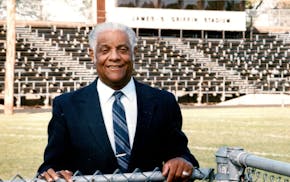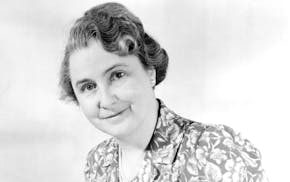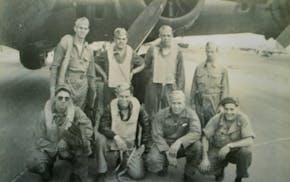On a summer afternoon 50 years ago, Virginia Piper was trimming pansies at her Orono home when housekeepers alerted her to two masked men entering the home with guns in both their hands. They tied up the two cleaners, handcuffed 49-year-old Piper and asked the whereabouts of her "old man," husband Harry (Bobby) Piper Jr., chief executive at the Minneapolis brokerage firm of Piper, Jaffray & Hopwood.
When she told them he was at the office, one of them said: "OK, Mrs. Piper, you're coming with us."
Handing her one of her own pillowcases, they ordered Ginny Piper to cover her head and lie down in the backseat of a green coupe. Before driving off, they left a typed ransom note for $1 million — the most expensive demand the FBI had ever seen up until that day, July 27, 1972.
The next day — handcuffed, wet, shivering, and chained to a tree more than 150 miles away in the Northwoods at Jay Cooke State Park — Ginny figured "that nobody would ever find me again."
But her husband had come up with the cash: 50,000 $20 bills stuffed into a canvas duffel weighing 110 pounds. Driving alone and without surveillance, Bobby followed a series of notes left by the kidnappers for two hours, ultimately leaving the ransom money in a car trunk behind the Sportsman's Retreat bar north of downtown Minneapolis.
About 1 p.m. on Saturday — 48 hours into her harrowing abduction — Ginny heard a car door slam and yelled out "Help!" The kidnappers had revealed her location to a Plymouth pastor, who called the FBI. Five agents came "running through the underbrush," Ginny told reporters the next day. "I've never been so glad to see people as I was to see them."
The oldest of the Pipers' three children, 78-year-old Harry Piper III, said in a recent e-mail from his home in Oregon: "My mother was a very special and very brave woman who probably saved her own life by engaging her captors in conversation … I know now that the FBI at the time assumed she would be killed."
Ginny Piper, who died in 1988 from pancreatic cancer at 65, would be 100 this November. In some ways, her abduction was a story with a happy ending — but also one that left two nagging questions unanswered: Who were the kidnappers? And what happened to all that ransom money?
"I just want to know who did it," said son David Piper, 68, of Minneapolis, who was still living at home in 1972. He said his mother later suffered from what we today call post-traumatic stress disorder.
"The kidnapping was a devastating event that impacted our family for a long, long time," David said. "It still lingers, especially since there is no certainty as to who did it."
Only about $4,000 worth of the ransom's $20 bills turned up, at banks in Owatonna, Rochester, Austin, Kasson and Dodge Center. That leaves $996,000 still unaccounted for — "a big number that caught people's attention, mine included," Pine County Attorney Reese Frederickson said recently.
Pine County, about halfway between Orono and Cooke State Park, was the home of Donald Floyd Larson — one of the two men convicted of the abduction and then acquitted after an appeal prompted a second trial. Frederickson said there's no active investigation, "but who doesn't love a mystery?"
DNA can't solve the puzzle because two key pieces of evidence were destroyed: Larson's alleged fingerprint on a scrap of paper found in the woods near Piper, and a single hair belonging to the other suspect, Kenneth James Callahan.
"With DNA," David Piper said, "it would be a whole different ballgame."
Among the experts on the case is Minneapolis crime writer William Swanson, who wrote a riveting 2015 book, "Stolen from the Garden: The Kidnapping of Virginia Piper" (tinyurl.com/Swanson-Piper). "Many persons familiar with the case believe the job was too sophisticated for the likes of Callahan and Larson," said Swanson, who described the pair as "minor career criminals."
Callahan suffered a fatal heart attack at age 79 in 2004 after working for years as a carpenter in Cumberland, Wis., and Larson died at 82 in 2008 at the state prison in Oak Park Heights. He was Minnesota's oldest prisoner at the time, serving a life sentence for killing his wife Ruth, her lover and three children in rural Pine County four years after Piper's abduction.
Were those murders part of a jealous rage fueled by catching his friend in an affair with his wife? Or was Ruth the one who wrote the ransom notes, as some investigators theorize, and was about to talk to the FBI?
"It seems preposterous to me that Larson would kill five people to avoid a kidnap charge when the penalty for murder was much longer than kidnapping," Swanson said. Frederickson thinks Larson might have been involved, though "not the mastermind pulling the strings."
"As far as the legal system is concerned, no way did they solve that case," Bruce Hartigan, one of Larson's lawyers, said 10 years after the abduction. "We've got two or three people running around out there who pulled off the biggest kidnapping in history."
Curt Brown's tales about Minnesota's history appear each Sunday. Readers can send him ideas and suggestions at mnhistory@startribune.com. His latest book looks at 1918 Minnesota, when flu, war and fires converged: strib.mn/MN1918.

Minnesota History: Ad man turned Paul Bunyan into a folklore icon

Minnesota History: James Griffin used persistence to blaze a trail for St. Paul's Black police officers

Minnesota History: For Granite Falls doctor who tested thousands of kids for TB, new recognition is long overdue

Minnesota History: A New Ulm baker wearing a blanket fell to friendly fire in the U.S.-Dakota War


